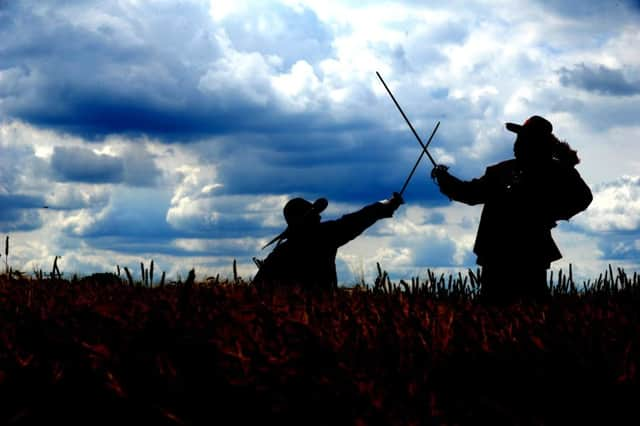How they dug up Sheffield’s part in the English Civil War
This article contains affiliate links. We may earn a small commission on items purchased through this article, but that does not affect our editorial judgement.


It is believed that there are more hidden historical gems to be found, buried under the ground. The challenge is to uncover these.
The plan involves using a bouncing light beam from an aircraft. It is a type of geophysics known as ‘profiling’, which is normally used for geology but is a novel approach for archaeology.
Advertisement
Hide AdAdvertisement
Hide AdProfiling involves creating ‘slices’ through the landscape - a bit like slicing through a cake to see where the jam is in the middle.
That process would help to digitally map out a complex network of defences, fortresses and redoubts constructed during the sieges of Newark.
The Civil War, which took place in the middle of the 17th century, will always resonate in Yorkshire. Events such as the Battle of Marston Moor made a profound impact on the area’s history.
The war was between the supporters of the king - Charles I - and those who backed the parliament. Yorkshire was divided by this conflict, which lasted until 1646, between Royalists and Parliamentarians.
Advertisement
Hide AdAdvertisement
Hide AdIn April, the king attempted to enter Hull but the gates of the city were shut against him. Actual fighting began in August and the royalists used York as their base.
The Sealed Knot is a civil war re-enactment organisation. They stage costumed demonstrations of what happened during those times.
Simon Wright, of the Sealed Knot, believes there could be much more of historical interest to be uncovered beneath the ground.
“Yes, there is probably a great deal of information to be discovered from the archaeology of sites relating to the English Civil Wars,” he said. “Good examples of this can be seen from the excavations at Pontefract and Sandal Castles.
Advertisement
Hide AdAdvertisement
Hide Ad“Also the relatively new techniques associated with battlefield archaeology have significantly changed our views of what happened at major battles like Naseby in Northamptonshire and Marston Moor near York.”
Dr Rachel Askew, University of Sheffield archaeologist, has been engaging with the National Civil War Centre and a range of stakeholders to plot a project that will combine the talents and skills of the university, museum and publíc to discover more.
The most impressive surviving earthwork in the region is the star-shaped Queen’s Sconce, which once provided a platform for Royalist cannons to fire on the Parliamentary forces. Dr Askew believes there are many more ‘redoubts’ lying hidden beneath the earth.
The last time that the siege works were scrutinised in this manner was in the early 1960s when a Royal Commission published a report. Back then, lasers and satellite imagery were science fiction. There is no better time than the 21st century though to keep delving into the mysteries of nearly 500 years ago.
Advertisement
Hide AdAdvertisement
Hide AdTo keep up to date with The Sealed Knot’s programme of events during 2016, visit www.thesealedknot.org.uk
CIVIL WAR - YORKSHIRE AREAS
Siege of Hull, 1642: Charles the 1st’s unsuccessful siege of the city - a major port possessing a large arsenal - sparked off a full-scale war.
Battle of Leeds, 23 January 1643: Amid a heavy snowstorm, battle raged for more than three hours in the afternoon. The victorious Parliamentarians took around 500 prisoners.
Battle of Seacroft Moor, 30 March 1643: This was a serious blow for parliamentary forces. Fairfax, their commander, was quoted calling it “the greatest loss we ever received”.
Advertisement
Hide AdAdvertisement
Hide AdCapture of Wakefield, 21 May 1643: A parliamentary victory which temporarily changed the balance of power in Yorkshire after they surprised the Royalist garrison.
Adwalton Moor, near Bradford, 30 June 1643: The strong Royalists defeated the parliamentarians, even though they had 3-4,000 men around Bradford.
Second Siege of Hull, September to October 1643: A victory for parliament at the high point of the Royalist campaign - and led to them re-establishing themselves in Yorkshire.
Battle of Selby, April 1644: A parliamentarian victory over the Royalists, which importantly opened the road from Hull to York for them.
Advertisement
Hide AdAdvertisement
Hide AdThe Siege of York, April to July 1644: A prolonged battle for supremacy, leading to Fairfax being made Governor of York by parliament.
Battle of Marston Moor - 2 July 1644: The Royalists lost what was reportedly the biggest battle in British history - and Oliver Cromwell called it “an absolute victory obtained by God’s blessing”.
Great Siege of Scarborough Castle: The Castle was bombarded for five months by parliamentarians, there was brutal conflict then the defenders finally caved in.